Work-in-Process
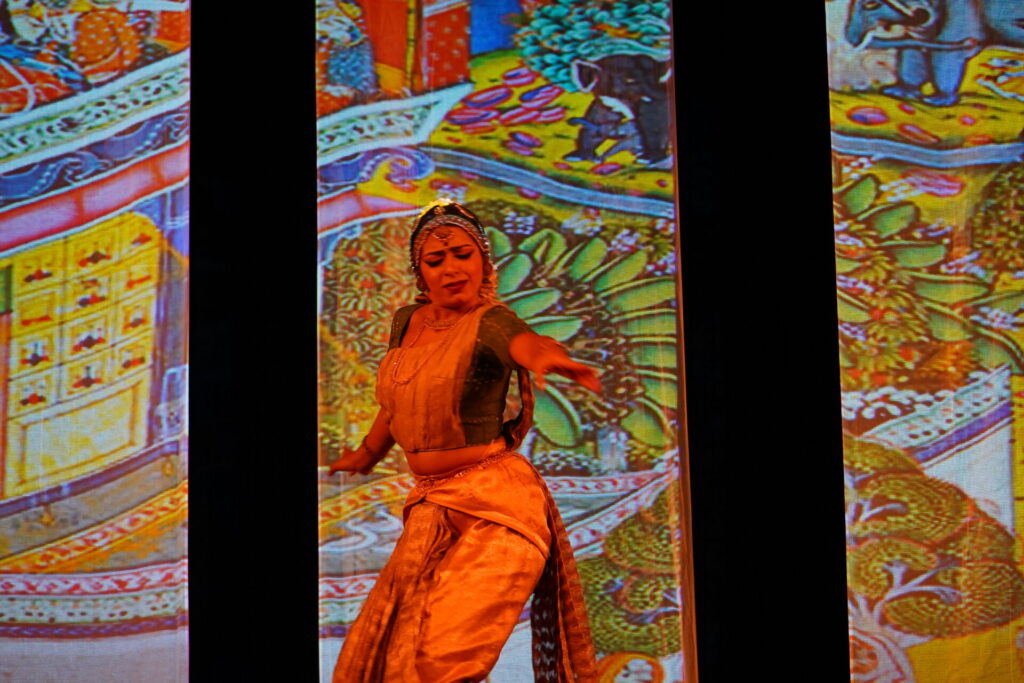
Bharatanatyam artistes, Rama Vaidyanathan and Dr Apoorva Jayaraman, who were amongst the chosen artistes who showcased their thematic new work under the umbrella of the theme, Ritu, curated by the Natyarangam festival at the Narada Gana Sabha in Chennai in August, decode their specific work and their take on its thought and treatment, in dance A Summer Surrender Dr Apoorva Jayaraman allows us insights into her treatment of Grishma When you received the theme Grishma from the Natyarangam Commitee, what was your initial response? I am born and raised in Bangalore, a city known for its great weather. Therefore, the one thing about living in Chennai that always irked me was the summer heat. It was the one thing I never managed to get used to, and I definitely did not enjoy. So, when I got to know that Grishma is the theme that Natyarangam was inviting me to work on, I thought to myself – “oh my gosh! “Irritation” is going to be my eternal sthayi bhava!!” For the first few days, the mind was a blank page. But midway in the process, I began to appreciate being commissioned to work on a theme that I wouldn’t have naturally gravitated towards, as without an “obvious” starting point. I had to go on a journey to find what it meant to me, and what I wanted to say. Personally, what is your take or relationship with summer? How much of the personal do you bring to your work, in general? Fatigued. Irritable. Underproductive. These are the first few words that I would use to describe myself in the Indian summer. But when I thought beyond this tip-of-the-tongue response, I remembered the sweet feeling of taking a shower after a tough three-hour rehearsal or class in the sweltering heat, and lying on my bed, feeling the warmth spread through my exhausted muscles. A drenched dance saree, sweat splashing from my braid… this, I realised, is the real deal, the real visual I have of the Chennai summers. One is dead by the end of a practice, but you never wish you didn’t have to do it. Spring is a time of hope and dreams. The monsoons, almost a celebration. But summer is a time of toil, a conscious journey through harsh and unfriendly times to go nearer one’s goal.I began to see summer as a time where the human spirit demonstrates an extraordinary ability for perseverance, for survival and an inexplicable thirst to soar. This personal identification is definitely where I’m drawing from and what helps me want to tell a story, or even have a story to tell. The one liner for me is “Summer – the fire in my soul”. An artist’s job is to extrapolate the specific to the generic, in a manner that it finds resonance with a large number of people, without either losing (or over indulging in) its idiosyncrasies and frailties. So to answer your question, yes, the seed is personal. The impulse for the story is personal. But the stories themselves are not necessarily so. Your concept note is an interesting exploration of a whole host of ideas that are connected with the notion of summer – romance, abundance, hope, fearlessness but also there is hardship and self-preservation; typically, what is your process of creating new work? Sometimes, the starting point of a work may simply be to explore something from an anthology of interest. I then read/explore/have conversations around the subject which slowly helps me understand the approach I want to take with the piece. Writing is the most important tool that helps me begin to articulate my ‘whys’ and to start to see a thread in my choices. Even though a first script may look either just like bare bones, or sometimes have too much clutter, the process of putting pen to paper strangely gives me the confidence to find my way. My biggest problem is knowing when to stop! In this regard, conversations with my teacher have always been my grounding factor – when I simply don’t know when to stop tweaking and fixing; or when I don’t know when to cross the threshold from research to visual stage, she has been my guide and compass. What is the kind of research that went into creating this particular work? In this particular instance, it started with reading a lot of literature to find references to summer. I read everything that came my way, shortlisting interesting portions from Kalidasa’s Rutusamharam, Kalithogai of Sangam Literature, Kavi Keshavdas’ Rasikapriya. For this particular project, Natyarangam greatly aided our process with strong starting points – talks and sharings from scholars like Dr Sudha Seshayyan. I came across a mention of some interesting songs on summer in an interview with artist Shubha Mudgal. Another of our resource persons Monali Bala helped me source and understand some of those which sounded intriguing. I had several rounds of conversations Dr Raghuraman, who each time draws me a further mile into the immensely fascinating nooks and corners of the world of Tamil literature, this time throwing at the me the exuberant verses of Kalingattuparani which embodies such potent imagination; and S Jayachandran, who always unsettles the equilibrium (in the best way) and impelled me to go beyond the “narratives” and find my eka-vakyata. In the world we live in, we don’t have the luxury of just shutting ourselves and focussing just on the work, right? How do you manage switching in and out of this process of being preoccupied with a work and also managing the everyday and the mundane? I visualise/dance in my head all the time. A lot of the creation of this work, in the sense of visualisation, has been happening outside the studio – in transit in an airport, in an auto getting from class to home, lying on bed waiting for sleep to hit etc. This time around I’ve also been doing some of the work on my students. This has been a fairly
Work-in-Process
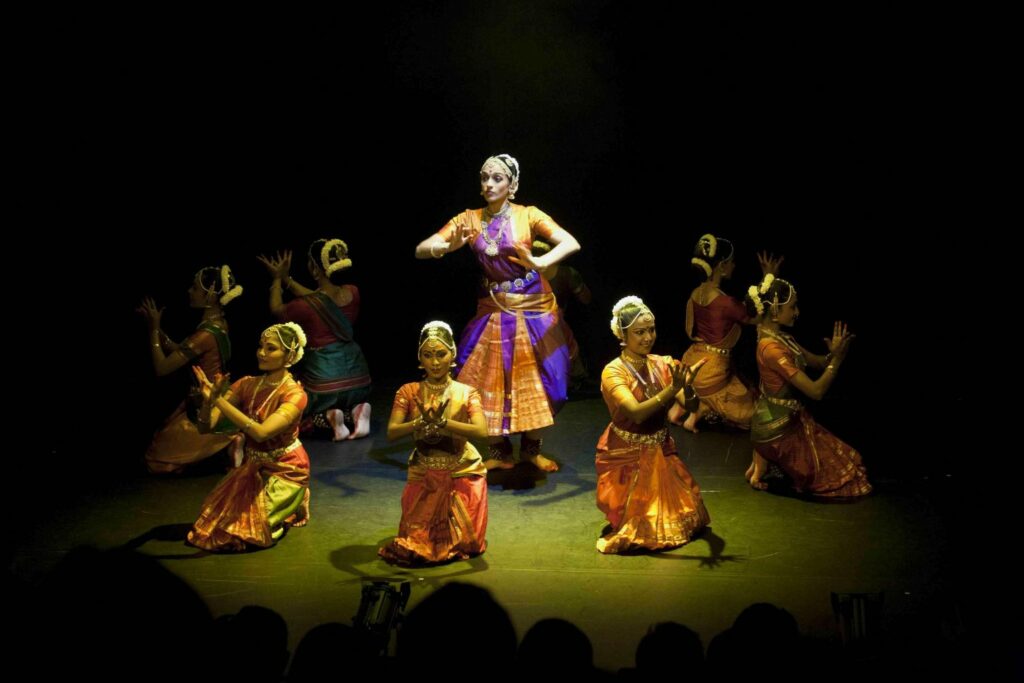
How does a choreographer who wears multiple hats, re-imagine an old work to make it relevant, and extraordinary at the same time? Read on for an interview with Aravinth Kumarasamy, Artistic Director of Nirmanika Re-imagined As a youngster Aravinth Kumarasamy says he was always very interested in the basics and nuances of architecture; “I travelled – in my pursuit to learn – to many ancient monuments in Asia appreciating their beauty and the many stories each of them hold within them.” This admiration and appreciation for the world of architecture is really what inspired him to conceptualise a dance production inspired by some of the ancient monuments. Say hello to Nirmanika Re-Imagined that premiered in its new avatar on February 26 and 27, at the Victoria Theatre, Singapore. Inspired by the architectural marvels of iconic temples of India and the influence beyond into Southeast Asia, this work is an iconic production that provides a deeper understanding about our Indian heritage and culture. Architecture and dance, albeit are two very different disciplines, that share commonalities in process and creation. Choreographers and architects, when creating new bodies of movement or conceptualising building infrastructures, are always posed with the question on how to manipulate space and light to construct new forms. Nirmanika, a dance production which means “architectonics” in Sanskrit, explores the forms and aspects of architecture through de-constructing ancient monuments such as India’s Taj Mahal and Indonesia’s Borobudur Monument through Bharatanatyam techniques such as nritta (movements) and abhinaya (expressions). Collapsing the performance into six segments of dance that elaborates on concepts such as geomancy, space, structure, philosophy, history and form. Nirmanika is ultimately about the beauty of architecture expressed through dance. In its original form, as envisaged by Neila Sathyalingam, Nirmanika explores some of India’s renowned monuments – Sun Temple (Konark), Meenakshi Temple (Madurai), Brigadeeswara Temple (Tanjore) and the India-inspired Buddhist monument, Borobudur in central Java, Indonesia. In this re-imagined version, the work includes five more monuments representing the five elements – Ekambareswarar Temple (Earth), Srikalahasti Temple (Wind), Arunachaleswarar Temple (Fire), Jambukeswarar Temple (Water) and Chidambaram Nataraja Temple (Ether). Nirmanika Version 1 was performed with a live music orchestra across the venues in the world. In its new version, Aravinth Kumarasamy, who also composed music for this work, pre-recorded the music with a stellar team of musicians including Carnatic musician, Sikkil Gurucharan from India. While the original costume and accessories as designed by Smt Neila Sathyalingam have been retained, the re-imagined version has an additional costume designed by Mohanapriyan Thavarajah of Apsaras Arts. Read on for an interview with the Artistic Director of Nirmanika Re-Imagined as he breaks down this work, for us! Aravinth, do you remember what was the exact moment when you decided you wanted to re-envisage Nirmanika? During the lockdown in late 2020 and early 2021, I realised that I could use the free time I had on my hands to re-imagine this work by Neila Sathyalingam, as 2022 also marks the production’s 10th anniversary. We had also returned from the Natya Kala Conference (NKC) which was held in late 2019 at the Krishna Gana Sabha in Chennai, where we had presented Anjasa, a production, which was created as a sequel to Nirmanika. Anjasa received much acclaim from the dance fraternity gathered at NKC and I thought it would be good for many to see Nirmanika which was where our journey towards exploring architecture and dance really began. As Artistic Director, how different is it to envisage something from the start vs re-imagining an existing work? Yes, I must admit this was a daunting task indeed as Nirmanika had already been perfected with so much re-staging across numerous international tours etc. It was hard to envisage how I would edit any of its segments. But the process helped me understand that there is always room for new ideas. And herein was born a new act on the Panchabootha Sthalams. This was created from scratch and I re-worked some of the existing choreographic sequences. How did you decide what must go, and what must remain? Can you please give us an example? Most of the acts were retained, and a segment on the great monument, Taj Mahal was completely removed as all the monuments were based and inspired by the Pallava and Chola architecture. In that context, Taj Mahal seemed totally out of place. On one of the international tours, I had added a segment on the Mahabalipuram Pancha Rathas, then again, the other monuments part of production, were all “living” monuments and both Mahabalipuram and Taj Mahal aren’t. Hence, I decided to center the theme around living monuments. Has Nirmanika also been re-imagined for a different kind of audience? If yes, what is that understanding you bring as its director? After a decade, I wanted to appeal to another generation of young audiences. As a result, the choreography was infused with a fresh dose of lighting and design. The direction while re-imaging it was to use avant-garde technology without ever losing the aesthetics of the monuments and the art of Bharatanatyam. As this work’s Artistic Director, how would you break the process of its choreography into parts? And what are they? As an Artistic Director, one has to visualise the coming together of music, choreography, movement vocabulary and lighting design. Since I conceptualised, composed music and choreographed many of the segments, it was possible to direct this with a holistic view. You are also this work’s music composer? Did it help that you were part of the original and therefore the work was very close and part of your system? I learnt from my Manasika Guru, Dr Padma Subrahmanyam on the art of “Seeing Music and Listening to Dance”. This has helped me a great deal to visualise the music and feel the rhythm of the movements and the expressions to choreograph. We like the title of this work; re-imagined; what does that mean vs re-visited? Re-imagining means going back to the drawing board without any attachments on
Work-in-Process
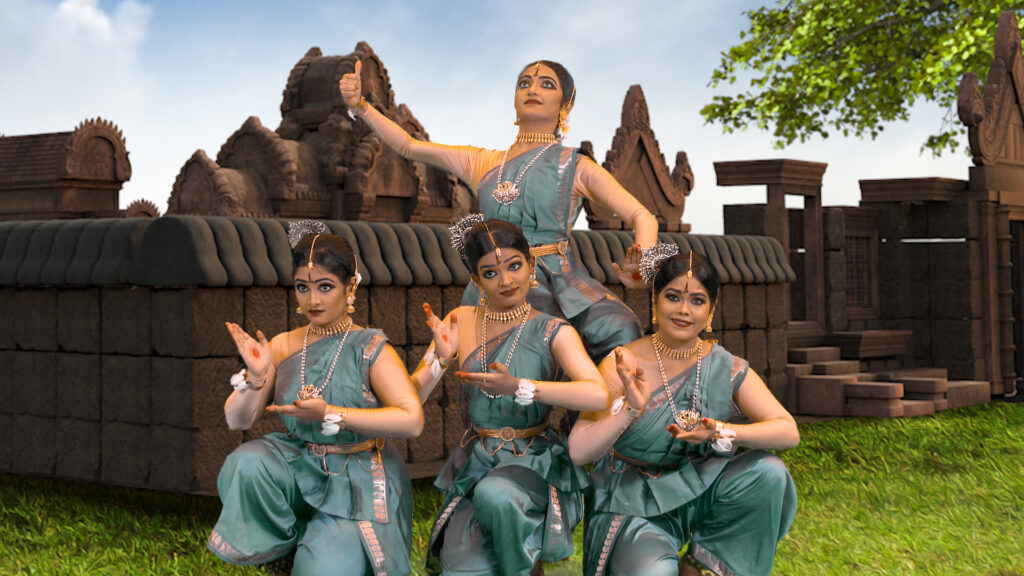
Monuments, architecture, music, costume, lighting and imagination intersect in this production called AMARA by Apsaras Arts. An interview with its creator, Aravinth Kumarasamy Aravinth, what was the genesis of this production? When it was born, how did it develop? What is the kind of research that went into this? In 2013, I had conceptualised a dance theatre production ANGKOR – An Untold Story which was based on the historical details and events on how this grand monument in Cambodia was built by the Khmers. As part of the research for this production, we had also studied, researched and visited Banteay Srei, a smaller and earlier monument to Angkor Wat in Cambodia. A brief description of this monument was included in the narrative of the production of Angkor. In 2020, during the lockdown due to the pandemic, we decided to work on a digital dance film using CGI technology, and at that time, we decided to tell the stories carved on the walls of Banteay Srei through dance and music. The earlier research done was handy and further details of the monument were researched. Banteay Srei has some interesting details which inspired us to write lots of stories, like the following: The Jewel of Khmer Architecture: Due to the miniature size of the structures, uniqueness of the tiny details, and exceptional refinement of the sculptures, it is popularly admired as a ‘Precious Gem’, or the ‘Jewel of Khmer Art.’ Can you give us an insight on the Aharya abhinaya, especially for this production. Mohanapriyan Thavarajah, worked on creating a Cambodian inspired costume, accessories and hairstyling of the dancers. The dancers take on the role of the yoginis who were celebrated in this temple, hence we gave them an appearance of divine Cambodian demi-gods. The challenge was to create all the costumes in Singapore itself as we could not travel to India or to any international destination due to the pandemic. Singapore had all the required Cambodian fabrics, however, we had to get tailors who make regular sari blouses to make dance costumes. Mohanapriyan spent many hours sitting alongside the tailors to get this done for their entire cast of eight dancers. What about the music? Why is the music of Amara unique? Were there lyrics specially written for the theme? Dr Rajkumar Bharathi and Sai Sharavanam created the original music score and got it recorded in Chennai working remotely and online with me. This was the first time where we were not in the studio to discuss, or be present when the music was being recorded. Rajkumar Bharathi created exclusive compositions for Amara which resonated with the beauty of the monument and the secrets it held within. How have you drawn parallels with the Khmer regime and the Indian subcontinent? This attempt to identify connections and linkages is crucial to the work of Apsaras Arts, right? I have been inspired by the diverse cultures of Southeast Asia and its roots with Indian culture and Hindu concepts and legends. Amara is also along the line of our exploration at Apsaras Arts to bring cultures together . Banteay Srei contains details of bas relief carvings on many Hindu stories, which Amara brings to life through dance. My two favourites are: Mohanapriyan has done a wonderful job of choreographing these stories and the cast of dancers brought each carving alive through their dance. How has the architectural beauty of Bantaey Srei been captured in this production? What is Apsaras Arts’ fascination with capturing architecture onto stage in the form of dance? Monuments have been my fascination for a long time. In 2010, my journey started exploring architecture through the production Nirmanika, then Angkor, followed by Anjasa and then with Amara. Each of them brings out different aspects of the architectural marvels of the monuments. In Amara, the audience sees the bas reliefs come alive.
Work-in-Process
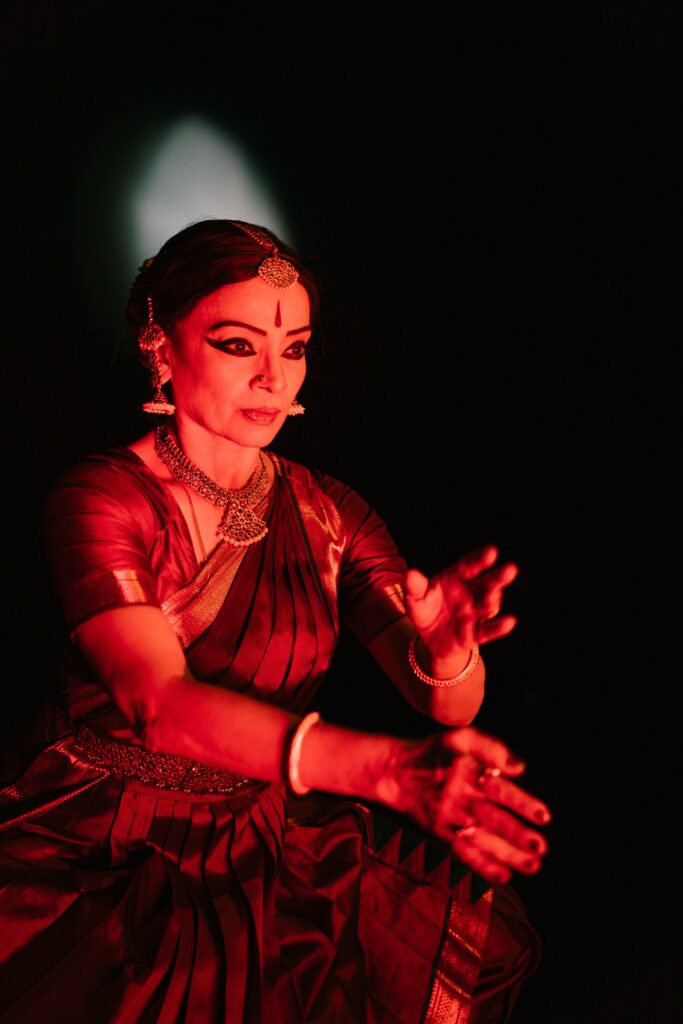
In conversation with Bharatanatyam exponent, Malavika Sarukkai as she decodes the process of how Anubandh, her latest solo production, came to be What was the genesis of Anubandh? The solo production Anubandh – Connectedness evolved during the last two years. It is an artistic response to the isolation, loneliness, trepidation and fear arising from the pandemic. I needed to express my feelings and observations and the only way I could do that was through dance. Are all ideas of your productions born in moments of solitude and introspection or have there been cases when in the moment of frenetic activity, a thought for a production came your way? An impulse to create can come about quite unannounced. At times, a deep emotional stirring can give rise to a concept which, in turn, transforms into a dance production. And at other times it is a restlessness within, which seeks expression. In my experience at all times the idea persists over a length of time which finally culminates in creative expression. I have learnt over the years that this critical phase cannot be rushed as the concept must mature and evolve naturally. Anubandh was also created in a world that was inherently silent but also there was so much chaos and uncertainty? How do these two contrasting emotions find expression in the work? The world was chaotically silent and in pause mode during the pandemic. It was gravely unsettling. I needed to anchor my observations and feelings. Anubandh grew as a response to find myself individually and collectively in a world of turmoil. The production seeks to reclaim our primordial relationships with the Sun and the Moon, as also with the Five Great Elements, the Pancha Mahabhutas as they are honoured in India – Earth, Water, Fire, Wind and Space. The work re-inforces our deep links with the Great Elements – the generosity of the Earth, the rejuvenating powers of Water, the caressing pleasure (sukha) of the Wind, the unending depth of sorrow (dukha) in Fire, the wonderment in sensing Space and knowing that the same life-breath pervades all. Why is Anubandh special to you and why is it a reminder of the spirit of inter-connectedness? At a deeper level Anubandh is about learning to co-exist and live life with a sense of connectedness and inclusivity. It’s about seeing ourselves as humanity. At a time of uncertainty in a fractured world, Anubandh is a call to the transformative power of hope. What went into the choreography of Anubandh and how tough was it to work with collaborators on an online platform? Working with my team linked only via online calls etc, was exceedingly tough. It was fragmenting as it lacked the warmth of real-time interaction. The only other choice was to abandon the project, which was not an option. Working intensely right through the pandemic was learning to survive keeping the body, mind and spirit alive and purposeful. Anubandh is as much a singular pursuit as it is a collective call for the need to connect with each other, right? How does music play a role in this delineation? The narrative in Anubandh moves from the personal to the shared and from the individual to the collective. The music concept is an area I pay a lot of attention to as I work on creative detailing. Music texturing plays an important role in all my choreographies. Keeping this in mind the coming together of multiple voices, percussion instruments and other instrumentation is a complex and delicate approach, as their needs to be a sense of dialogue with space for silence. Only then does it become a collective enterprise with flow. EOM
Work-in-Process

Rice & Shine! In this month’s Work in Process section, we bring to you ARISI: Rice, an Apsaras Arts and Esplanade Theatres on the Bay co-production, that talks about the physical as well as symbolic significance of rice in many Asian cultural and aesthetic practices. Read on to know more about the thought, process and making of this production. Apsaras Arts presents ARISI: Rice, a cross-cultural and multi-disciplinary performance inspired by the grains of life, that links humanity across Asia. This work is inspired by the social, cultural and aesthetic practices borne by cultivation and consumption of rice in these regions. From birth celebrations to funeral rites, rice holds important physical as well as symbolic significance in many Asian cultures. This production has been worked across three countries – Singapore, India and Indonesia. In a shift away from epic storytelling, award-winning Artistic Director, Aravinth Kumarasamy has imagined the dance production as a beautiful imagery that intersects stages of rice cultivation with gestural rites and rituals in life stages, where rice is the principal ingredient. It has had three years of thinking and research and has been in the making for more than 18 months. In this production, dancers from Apsaras Arts share stage space with their traditional Balinese peers; the work also includes dance elements of the Balinese Kebyar Duduk, Kebyar, Legong and Joget Bumbung, choreographed by Professor I Wayan Dibia along with the company’s Resident Choreographer, Mohanapriyan Thavarajah. Together, they have re-imagined stories in the paddy fields and celebrate the life stages. This new work has enabled Apsaras Arts to once again collaborate with some of the best creative minds from the industry – Dr Rajkumar Bharathi, its Music Composer, Sai Shravanam as its Music Producer, Director, Arranger and Sound Designer, Mohanapriyan Thavarajah as its Choreographer and Principal Dancer, and Costume Designer, Prof I Wayan Dibia, Balinese Choreographer and Principal Dancer, K Rajagopal, Filmmaker and Director, Gyan Dev Singh, Lighting Designer, Wong Chee Wai, Set Designer and Lim How Ngean as its Dramaturge. The production involves musical collaborations with the Singapore Chinese Orchestra that melodically enhances the music score composed by Rajkumar Bharathi. Directed and produced by Sai Sharavanam, the production features an immersive soundscape created through live Chinese instruments (played by Singapore’s twenty five year old Chinese Orchestra) and leading award-winning Indian musicians such as Bombay Jayashri Ramnath, D Sathyaprakash, Naveen Iyer, Pratik Srivatsava and other eminent musicians. It additionally includes Balinese Gamelan and Kecak choric singing to echo and accent certain scenes. Fabrics for the costumes are from indigenous sources from India, Bali and Indonesia and designs have been inspired by rice cultures across Asia. Mohanapriyan Thavarajah has painstakingly imagined the designs to give a contemporary twist to these dance costumes, yet keeping their heritage and cultural identities intact. Script for the choreography has been adopted by various sources on rice cultivation and rice cultures. Dr Nanditha Krishna from Chennai, has been instrumental to share many insights into rice culture across India and Asia. Additionally, for the first time ever, Aravinth Kumarasamy, Artistic Director, Apsaras Arts, collaborates with critically-acclaimed film director K Rajagopal, who contributes another powerful filmic layer of stories from former farmer migrants who now eke an existence in developing foreign lands. Filmmaker Rajagopal has followed some of these younger generations in Singapore and back to their rice fields in Thanjavur, South India to tell these stories which are thought provoking in appreciating the big question of our lifetime – sustainability of Rice farming! ARISI: Rice will premiere on November 25- November 26, 2022 as part of the Kalaa Utsavam, Indian Festival of Arts 2022 at the Esplanade Theatres on the Bay, Singapore
Work-in-Process
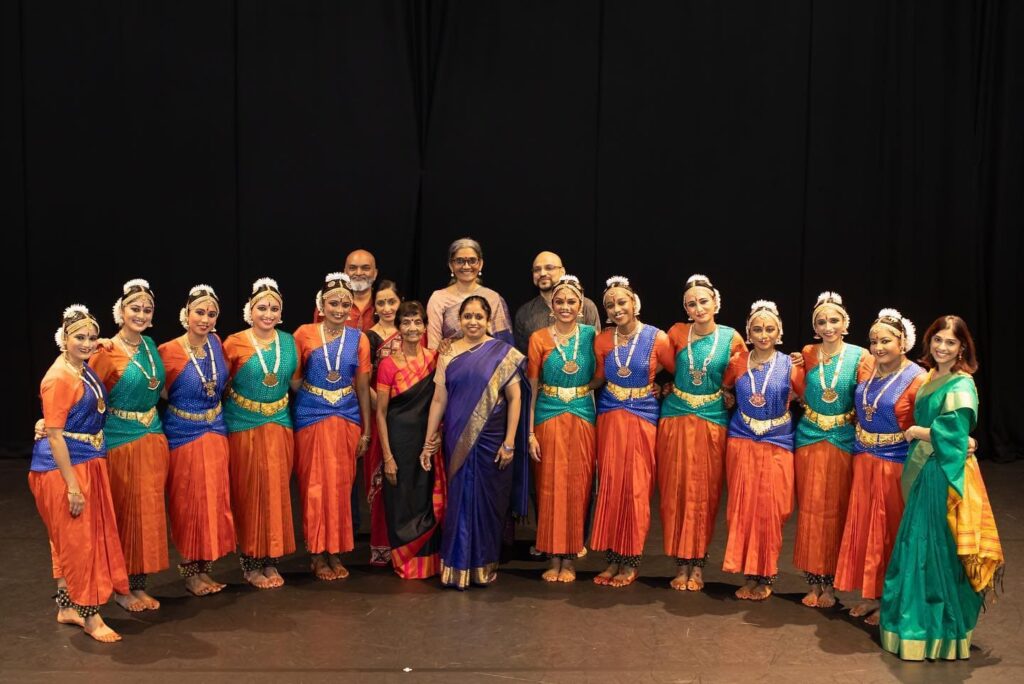
All Things Under the Sun Lakshmi Krishnan and Sujatha Rajagopalan, senior teachers from the Temple of Fine Arts, Singapore, jointly explore their new work Surya – An Awakening, with their fellow dancers. A sneak peek into the process behind the work Surya, your latest production, is a search, a seeking. What triggered this idea? It had been a long time since the full strength of our Bharatanatyam dancers had come together as one. Our dancers and students were all growing individually, one by one finishing their Arangetrams and continuing their learning journeys, training and explorations. But during the years of the pandemic there were many restrictions, and we couldn’t be together in the same space. That’s how Surya began – with a desire, an idea of wanting to be together in the same space and share the energy that comes with being together. In coming together, we experience warmth, energy and vigour. All the same things we receive from the sun. In Surya, the production, we awaken once again the spirit of moving together, getting things done with newfound ardour, sincerity, light and love. In most of your productions, there is a notion of seeking, of finding; why is this integral to your dance and to your journey as an artiste? I think the idea of seeking is fundamental to every student of the arts and to myself as a life-long student as well as a teacher to other students. The idea of seeking is also something that is very close to the Temple of Fine Arts, as well. Our Founder established the Temple of Fine Arts and set us on a journey to seek and share beauty, love, light, art just for the love of it. And it is never done alone. Yes, the seeker seeks, but there is always the sublime who helps to shine light on the path, to help us across to the other side of the river; whether it is providence or a teacher or the energy of the group that acts as our boatman. Surya is an idea dancers have dabbled with often. What sets this apart? And how? Ours is an inward journey through three items. Our search for the question of what the sun means to us happened during the process and it is interesting because the search and quest for answers has been a true one, and not just for the show. With Surya, we are trying to go deeper into the subject. Yes these are things we have done before or subject matters we have explored, but when we go deeper we also awaken our senses to new discoveries and revelations. Both for ourselves as choreographers and for our dancers who have different levels of experiences, who are all awakening to the nuances and depths of Bharatanatyam in different ways. Surya is a performance in Bharatanatyam inspired by the traditional solo margam repertoire structure, but explored through a group ensemble. It has been very fulfilling to work together with this group of young adults and dancers, to listen to their thoughts and see how the different imageries and meanings of lyrics have now unfolded. Take us through the process of how an idea translates into form and expression? Typically how long do you work on a production? A production takes a long time, from inception to bouncing around ideas, back and forth with storyboarding, music, and iterating through dance. It typically takes about a year. For Surya, most of the items had already been choreographed as solo pieces of work, and were completely re-looked and re-worked for 11 bodies to create so much more depth, imagery and meaning. We also had the challenge of working with 11 dancers at a time when the Temple of Fine Arts was moving its premises and there was a shuffle in rehearsal space availability. Our dancers worked closely with us, we worked closely with our dancers, and we are very proud of what we are sharing on stage in a few weeks to come. What about lighting, costume, etc. what role do they have to play? The lighting will serve to enhance the thought process of the dance and to also help bring out imagery and formations to elevate the experience. We have kept costumes simple but the colour schemes will go with the theme of Surya. Are your creations truly collaborative in nature? How does that elevate the whole process and experience? We are blessed to be working with a group of mature young dancers, who are encouraged to contribute ideas for group choreography. The safe space we have created for them has enabled them to actively be involved in giving suggestions to do different aspects of the choreography be it formations, imagery or even movement. In this way we have seen them actively grow over the past few months and it has been a rewarding experience for us, to say the least. We have collaborated with our musicians at the Temple of Fine Arts to also enhance the experience of music for the ensemble work. Our dancers have also taken interest in costuming, designing brochures and posters, publicity and marketing. We have allowed them this platform to grow by collaborating, to enter the space, to bring in their expertise in these areas. We are also working with a professional lighting designer. Having been a dancer himself and worked on several dance productions with us in the past, he serves to enhance the experience by understanding the choreography better. It is a gratifying experience for us to see our dancers being involved in the full process of the production, so that they are growing in a more holistic way as artistes.
Work-in-Process
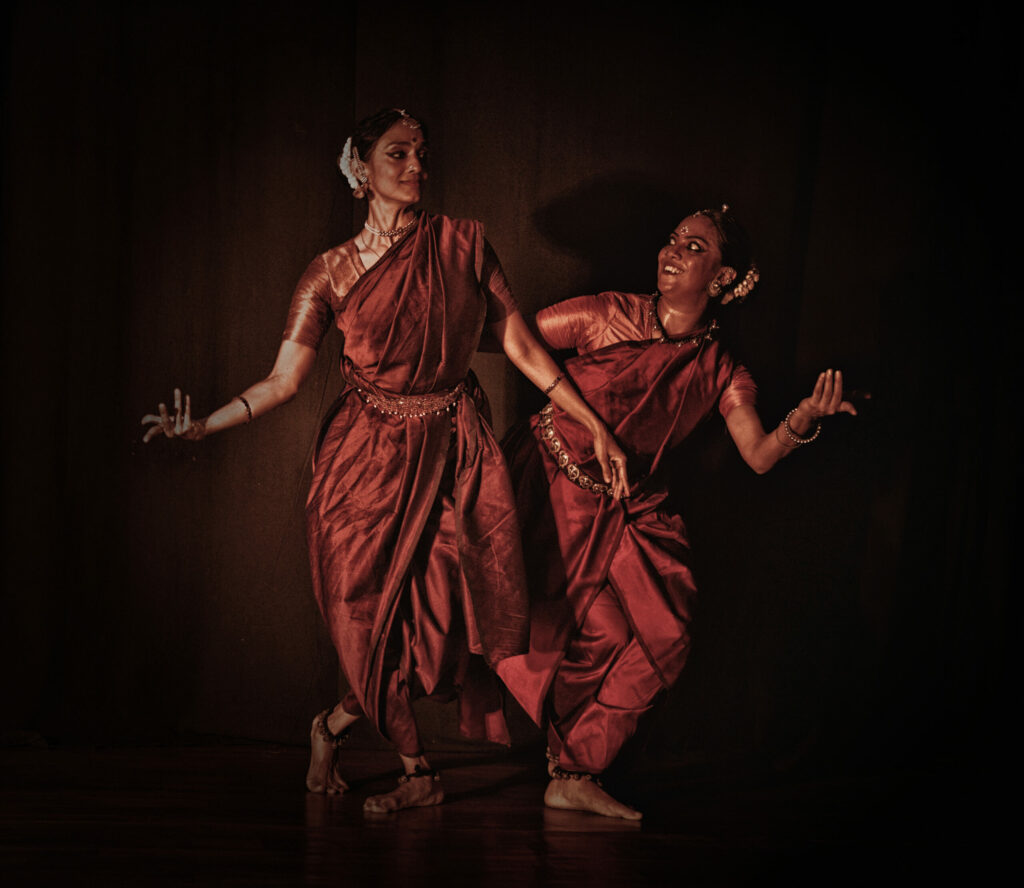
Ode to the Senses The classical styles of Odissi and Bharatanatyam, conceived and performed by artistes Shashwati Garai Ghosh and Lakshmi Parthasarathy Athreya, come together to create Anubhav, a sensory experience. Read on for how this work came to be in an interview that combines the voices of both artistes What is the genesis of Anubhav: Deeper with the Senses? It all started from a very honest friendship and vibe as thoughtful artistes. As solo artistes, how important is it to have a good working relationship both professionally and personally? Any art form requires a sense of collaboration. Though we call it a solo, it is honestly a lot of teamwork. As dancers we cannot create or present anything in isolation; we need a team with good work ethics, those who are committed to the project and are keen to maintain good relationships to keep the process going. What inspired the title Anubhav? We both are at a phase in our lives where we are keen to present and share our experiences and artistic ventures with a larger universe. Anubhav occurred in a very organic manner and fit itself beautifully into the form of a production that brings both our aesthetics and artistic sensibilities to the fore. We had the fortune of witnessing Anubhav in Chennai. Why is it essentially a sensory experience? Anubhav speaks a lot about deep and intense senses, both physical and emotional. You have already premiered the work in Chennai, Bangalore and Kolkata. Is the work evolving as it travels across cities and what are the key takeaways from it? Absolutely! Dancing as duets, with two different classical dance forms has been challenging and at the same time, a very welcoming experience. To remain in our respective genres but also intertwine with each other’s sensibilities and create one vibe has been a real learning process. Anubhav will grow and mature with our artistic growth. Also it will remain open to creative changes so that it evolves more.
Work-in-Process
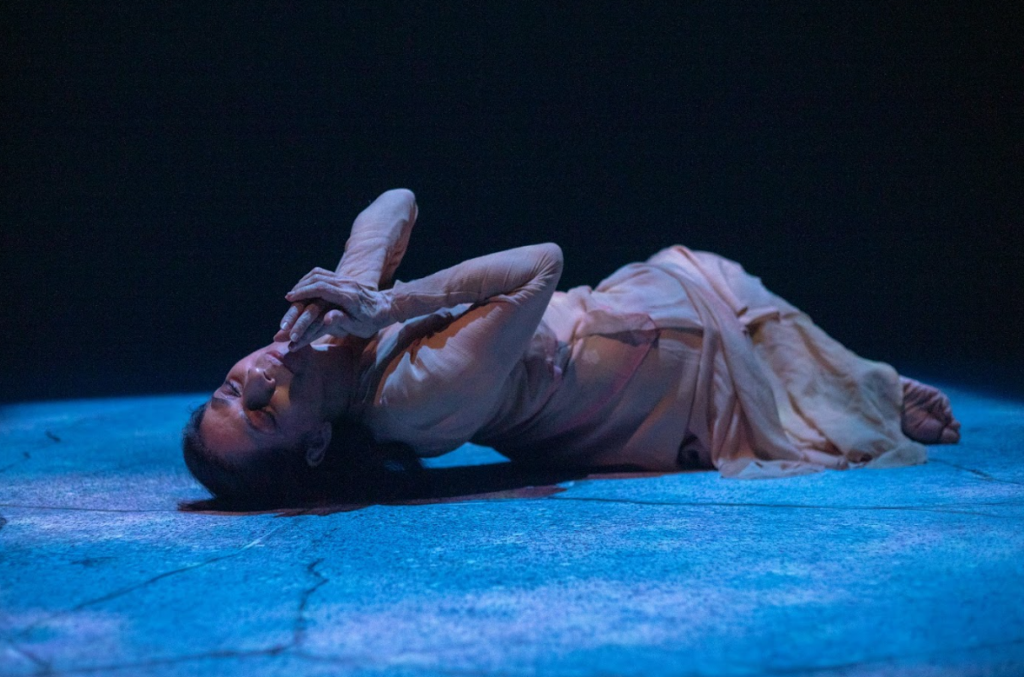
Peeling the Layers… Of female sexual desire… Leading Kathak exponent, Aditi Mangaldas talks about her bold and brave new work, Forbidden, and the story of how it came to be Surely, the idea of Forbidden didn’t happen one day or one night or in a moment, right? But what was that final moment when you decided to distill the thoughts in your head and create a work out of it? Most of my choreographies start off on an autobiographical note, hopefully, eventually opening out in a parabolic universal trajectory; it was the case with Forbidden too. The idea for any production of mine, whether classical or contemporary dance based on Kathak, has always brewed within me for months. If you are open to the pulse of life, then a piece of music, poetry, literature, architecture, movement, nature in its intense beauty and fury, a beautiful painting or sculpture becomes the inspiration and the trigger point. A small seed germinates within your being. For many years I was observing how female sexual desire was trapped in taboos and societal sanctions. Though I come from an extremely liberal family and have lived life mostly on my own terms, these societal taboos do creep in insidiously. The question haunting me was, why is the world scared of female sexual desire? Why are women – the world over – from conservative as well as liberal societies, sanctioned, judged, controlled, hounded, shamed and eventually punished because they have the courage to own their desire? What is the root of this fear? In its very title, Forbidden has a quality of the mysterious in it; something we must not; what was it like for you to explore or traverse into a zone like this? Did you find freedom in the process of this exploration? As women, we grow up realising the taboos attached to female sexual desire – it’s a lived experience, no matter where we come from. As an artiste, I feel compelled to confront these taboos, to acknowledge female sexual pleasure and the ownership of it, which is forbidden. Sexuality is a private affair but all the sanctions attached to it requires and demands taking a stand on the universal, public and personal front. It was not an easy subject, as I realised myself, how deep rooted this fear of female sexual desire was. Quoting the mythologist and storyteller, Devdutt Pattanaik, “… fantasy frightens us, especially female fantasy… One way of regulating fantasy has been by propagating stories where women who pursue their desires are viewed as dangerous, hence need to be restrained for social good.” The process of Forbidden, was like peeling an onion laboriously with every peel making me realise how entrenched this aspect of the forbidden is. In contemporary dance and in the works that you create there is a dramaturg; what is the role of the dramaturg and why is this not yet a prerogative of the classical? For me, as a classical dancer, the aspect of questioning myself has always been interwoven within the repertoire, constantly requiring me to be vigilant. The training, if honestly received, imparts the ability to question oneself fearlessly and critically. Thereby making one their own dramaturg. However, I have not developed this sensitivity when applied to contemporary dance based on Kathak. The dramaturg, in this case Farooq Chaudhry, became the third eye, constantly questioning the intention of every aspect of the production. There is detailed introspection, to ensure honesty towards the work. Female sexual desire is in itself a complex notion to navigate because so little is written or spoken about it for various reasons; what was it like to articulate this in movement? What were some of the challenges you negotiated along the way? The biggest challenge was to confront my own walls, as a woman and as a classical Kathak dancer. The other challenge was transforming these emotions into movement. Forbidden is ferocious and innocent simultaneously. It became a huge challenge to maintain and communicate this duality throughout the piece without unnecessary verbal explanations. I explored many movement vocabularies, slowly letting a tiny essence of them be absorbed within this Kathak being. Forbidden has been realised after months of internalisation, debate, troughs and peaks; as each collaborator offered nuance to the work, till I found myself immersed in it. To create work like this also requires courage; would you like your personality to give your dance that courage or did dance give you the courage to become the person that you are? For me, any production is a two-way process. I would like to be immersed in dance just as much as I would like dance to be immersed in me. Artists are driven to explore subjects that consume them. That drive is a possession which compels artists to face and share provocative and difficult issues. In doing so, their immersion in dance and the dance immersed within their beings is a must and that becomes the fulcrum of the courage that is required for pieces like Forbidden. Lights also play a crucial role in the works that you create; what is the role of lights in this work? I try to encourage the viewer to enter any of my works at multiple and diverse levels. I do not want to put a full stop but like to leave a comma, letting the viewer add their own narrative. For maximising this, all collaborative inputs including light design have a major role to play. It has been a thirty-year dream of mine to work with the legendary light designer, Michael Hulls. Michael was actively involved, not only as a light designer but as a collaborator engaging in all aspects of the work. Only then can a homogenous light design emerge. The lights embody the duality of ferociousness and innocence – they tell a parallel and yet completely in sync narrative of Forbidden. You also acknowledge your mentor here; what is the role of a mentor while creating works like these and why